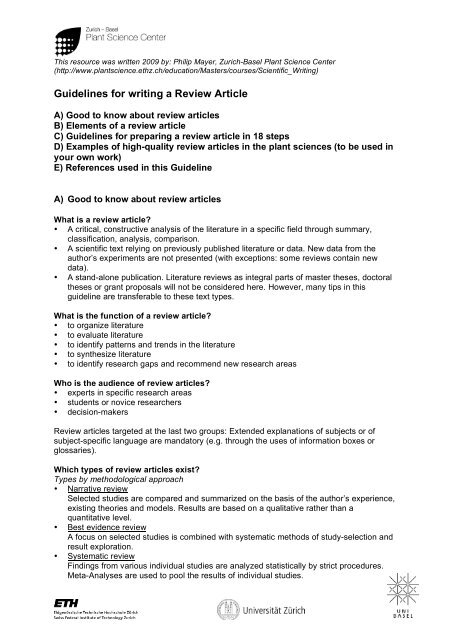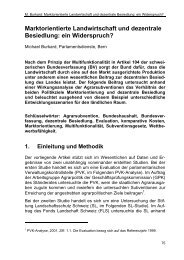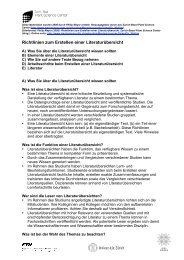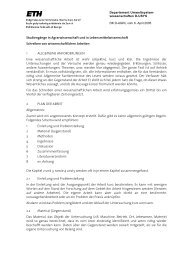Guidelines for writing a Review Article
Guidelines for writing a Review Article
Guidelines for writing a Review Article
Create successful ePaper yourself
Turn your PDF publications into a flip-book with our unique Google optimized e-Paper software.
This resource was written 2009 by: Philip Mayer, Zurich-Basel Plant Science Center(http://www.plantscience.ethz.ch/education/Masters/courses/Scientific_Writing)<strong>Guidelines</strong> <strong>for</strong> <strong>writing</strong> a <strong>Review</strong> <strong>Article</strong>A) Good to know about review articlesB) Elements of a review articleC) <strong>Guidelines</strong> <strong>for</strong> preparing a review article in 18 stepsD) Examples of high-quality review articles in the plant sciences (to be used inyour own work)E) References used in this GuidelineA) Good to know about review articlesWhat is a review article?• A critical, constructive analysis of the literature in a specific field through summary,classification, analysis, comparison.• A scientific text relying on previously published literature or data. New data from theauthor’s experiments are not presented (with exceptions: some reviews contain newdata).• A stand-alone publication. Literature reviews as integral parts of master theses, doctoraltheses or grant proposals will not be considered here. However, many tips in thisguideline are transferable to these text types.What is the function of a review article?• to organize literature• to evaluate literature• to identify patterns and trends in the literature• to synthesize literature• to identify research gaps and recommend new research areasWho is the audience of review articles?• experts in specific research areas• students or novice researchers• decision-makers<strong>Review</strong> articles targeted at the last two groups: Extended explanations of subjects or ofsubject-specific language are mandatory (e.g. through the uses of in<strong>for</strong>mation boxes orglossaries).Which types of review articles exist?Types by methodological approach• Narrative reviewSelected studies are compared and summarized on the basis of the author’s experience,existing theories and models. Results are based on a qualitative rather than aquantitative level.• Best evidence reviewA focus on selected studies is combined with systematic methods of study-selection andresult exploration.• Systematic reviewFindings from various individual studies are analyzed statistically by strict procedures.Meta-Analyses are used to pool the results of individual studies.1
Types by objective (Noguchi 2006)• Status quo reviewPresentation of the most current research <strong>for</strong> a given topic or field of research.• History reviewDevelopment of a field of research over time.• Issue reviewInvestigation of an issue (i.e. a point of disagreement or a question) in a specific field ofresearch.• Theory/model reviewIntroduction of a new theory or model in a specific field of research.Types by mandate• Invited reviews: experienced researchers are invited• Commissioned reviews: <strong>for</strong>mal contracts of authors with clients• Unsolicited submissions: researchers develop an idea <strong>for</strong> a review and submit it tojournal editorsHow long is a review article?<strong>Review</strong> articles vary considerably in length. Narrative reviews may range between 8,000 and40,000 words (references and everything else included). Systematic reviews are usuallyshorter with less than 10,000 words.B) Elements of a review articleTitleFunctionElementsHelping readers to decide whether they should read the text or not.Includes terms <strong>for</strong> indexing (e.g. in data bases).The title must be in<strong>for</strong>mative:• The title has to include important terms.• It has to indicate that the text is a review article.• It may include the message of the article, not just itscoverage (Gustavii 2003).The title must be short:• Keep the title concise.• A longer subtitle may be an option in case a specification isnecessary.TenseCitationsIn a title with results indicated: the present tense stresses thegeneral validity of the results and illustrates what the author istrying to achieve with the article; the past tense indicates thatresults are not established knowledge yet.NoneLength between eight to 12 words (Davis 2005)QuestionThe title should only be a question if this question remainsunanswered at the time of <strong>writing</strong>.2
List of authorsFunctionElementsDeclare intellectual ownership of the work,provide contact in<strong>for</strong>mation1) Decision on authorship:• Every person that contributed significantly to the literaturesearch, literature exploration and/or <strong>writing</strong> process.2) Order of authors:• The first author has done most of the research and writtenmajor parts of the article.• Authors between first and last author have contributed inone way or the other to the success of the project. Theymay be ordered alphabetically (indicating equality) or in asequence of decreasing involvement.• The last author usually coordinated the project and had theoriginal idea.IMPORTANT: Discuss authorship as early as possible!AbstractFunctionElementsTenseElementsTenseCitationsLengthIn<strong>for</strong>ms about the main objectives and result of the review article(in<strong>for</strong>mative abstract) or indicates the text structure (descriptiveabstract).Descriptive abstract - <strong>for</strong> narrative reviewsDescription of subjects covered without specific details. Adescriptive abstract is like a table of contents in paragraph <strong>for</strong>m.presentIn<strong>for</strong>mative abstract - <strong>for</strong> systematic and best evidence reviews1) Objectives: One or two sentences describe the context andintention of the review.2) Material and methods: One or a few sentences provide ageneral picture of the methodological approach.3) Results: A few sentences describe main outcomes.4) Conclusions: One or two sentences present the conclusion(which is linked to the objectives).objectives: presentmaterial and methods, results: pastconclusions: presentusually noneusually 200 to 250 wordsTable of Contents3
FunctionNoteShows the readers the organisation of the text. Helps orientationamong sections.Some review journals print an outline/table of contents at thebeginning of the article, others do not. In general, these arerecommended <strong>for</strong> extensive narrative reviews.IntroductionFunctionElementsTenseCitationsLengthNoteProvides in<strong>for</strong>mation about the context, indicates the motivation <strong>for</strong>the review, defines the focus, the research question and explainsthe text structure.Elements of a three paragraph introduction (after Anonymous2003).1) Subject background. The general topic, issue, or area ofconcern is given to illustrate the context.2) “Problem”. Trends, new perspectives, gaps, conflicts, or asingle problem is indicated.3) Motivation/justification. The author’s reason <strong>for</strong> reviewing theliterature, the approach and the organisation of the text aredescribed.present (use past tense <strong>for</strong> the description of your methods andyour results)manyBetween 10% and 20% of the core text (introduction, body,conclusions).Make sure to have a narrow focus and an explicit researchquestion. Indicate these two points clearly in the introduction.Give theoretical or practical justifications <strong>for</strong> the need <strong>for</strong> a review.Body: Material and MethodsFunctionElementsSystematic and best evidence reviews have a methods section.This section enables motivated researches to repeat the review.Narrative reviews do not have a methods section but shouldinclude some in<strong>for</strong>mation about applied methods at the end of theintroduction.The material and methods section contains <strong>for</strong> examplein<strong>for</strong>mation about: data sources (e.g. bibliographic databases),search terms and search strategies, selection criteria(inclusion/exclusion of studies), the number of studies screenedand the number of studies included, statistical methods of metaanalysis.4
TenseCitationsLengthNotepastfew (e.g. to statistical analyses or software used)Approx. 5% of the core text (introduction, body, conclusions).Make sure that data sources are clearly identified. Precision hasfirst priority in the material and methods section.Body: Main Part of the <strong>Review</strong> <strong>Article</strong>Section structureA coherent structuring of the topic is necessary to develop thesection structure (Bem 1995). Subheadings reflect the organisationof the topic and indicate the content of the various sections.Possible criteria <strong>for</strong> structuring the topic are:• methodological approaches• models or theories• extent of support <strong>for</strong> a given thesis• studies that agree with another versus studies that disagree• chronological order• geographical locationParagraph structure • Cover one idea, aspect or topic per paragraph.• Avoid referring to only one study per paragraph; considerseveral studies per paragraph instead.Links • Frequently link the discussed research findings to the researchquestion stated in the introduction. These links create the athread of coherence in your review article.• Link the studies to one another. Compare and discuss theserelationships.TenseAccording to Ridley (2008) three tenses are frequently used:• Present: reporting what another author thinks, believes, writes,reporting current knowledge or in<strong>for</strong>mation of general validity,e.g. It is believed…• Simple past: referring to what a specific researcher did orfound, referring to a single study, e.g. They found…• Present perfect: referring to an area of research with a numberof independent researchers involved, e.g. They have found…5
CitationsLengthNoteCitations are usually indirect but in some cases pointed andrelevant remarks might be cited directly.• Non-integral references (indirect): The author’s name, or anumber referring to the reference list, appears in brackets.Non-integral references emphasize the idea, result, theory etc.rather than the person behind it (Ridley 2008). Most referencesin biology are non-integral.• Integral references (direct): The author’s name has agrammatical function in the text. As Ridley (2008) points outthis type is appropriate to emphasize the contribution of aspecific author.70 to 90% of the core text (introduction, body, conclusions).Make sure to organise the different pieces of in<strong>for</strong>mation into a lineof argument. An appropriate organisation of in<strong>for</strong>mation is allimportant<strong>for</strong> the quality of a review (Day & Gastel 2006).Throughout it is important that the idea/topic (paragraph 3 of theIntroduction) drives the article and not the literature used; write anidea-driven, rather than literature-driven article!ConclusionsFunctionAnswer the research question set in the introduction.Elements • implications of the findings• interpretations by the authors (kept separate from factualin<strong>for</strong>mation)• identification of unresolved questionsTenseCitationsLengthNotepresent: summarising and drawing conclusionspresent perfect: referring to an area of research or a body ofliteraturefew or none5 to 10% of the core text (introduction, body, conclusions).Make sure to have a clear take home message that integrates thepoints discussed in the review. Make sure your conclusions are notsimply a repeat of the abstract!AcknowledgementsFunction • Expresses gratitude to people who helped with the literaturesearch, the structuring of the material or in the <strong>writing</strong> process(but whose contribution is too small to justify co-authorship).• Expresses gratitude to funding organisation and specifies thefunding program (often required by funding agencies).6
Elements • Full names of people and their specific contributions to theproject are given.• The name of the funding agency and program as well as thegrant number and the person to whom it was awarded arementioned.TenseCitationspresent (past tense when referring to funding agencies interminated projects)noneReferencesFunction • Shows interested readers how to find the literaturementioned in the text.• Acknowledges the work of other scientists.• Compulsory to avoid charges of plagiarismElementsInclude every reference cited in the text. Do not include additionalreferences. Avoid internet sources. If internet sources must beused, find the original source <strong>for</strong> the internet reference, check ithas been correctly cited and cite it directly.LengthA range between 50-100 references is in most cases appropriate.Note • For narrative reviews the inclusion of all relevant, highqualitystudies is the target.• Systematic and best evidence reviews need explicit criteria<strong>for</strong> the inclusion/exclusion of studies from which they gotthe data.Illustrations: Concept MapsFunctionConcept maps are used in review articles to visualize thestructuring of the topic, to show the relationships between studies,concepts, models or theories.Organisation of dataLegendNoteBoxes with terms or names are arranged in a two-dimensionalspace. Arrows are used to link boxes. Specifications of therelationship are written on the arrows.The legend describes the concept map’s content. It is specific andin<strong>for</strong>mative (it should be possible to understand the map withoutreading the full text).Concept maps are very useful to display complex relationships.BoxesGlossaryOften provided to explain terms/concepts <strong>for</strong> those who areinterested in certain issues more in depth.Often provided to explain terms particular to a subject area so thatas broad an audience as possible may be reached.7
If you want to includetables or figures inyour review article……see <strong>Guidelines</strong> <strong>for</strong> <strong>writing</strong> a Research <strong>Article</strong>C) Preparing a review article in 18 stepsstagestepprepare 1. narrow the topic, define a few research questions orhypotheses2. search <strong>for</strong> literature sources, refine topic and researchquestions during the search *3. read, evaluate, classify and make notes4. redefine the focus and the research questions, define thetake-home message5. compose a preliminary titledevelop structure 6. find a structuring principle <strong>for</strong> the article (e.g. chronological,subject matter, experimental procedure)7. prepare an outline, find headings <strong>for</strong> the sections in the textbody8. plan the content of each paragraph in the different sections9. prepare tables, concept maps, figureswrite draft10. draft the methods section (if needed)11. draft the body sections12. draft the conclusions13. draft the introduction14. draft the abstractrevise15. revise drafts of different sections, abstract & title, tables,figures & legends16. revise citations and references17. correct grammar, spelling, punctuation18. adjust the layout* In systematic and best evidence reviews additional points have to be defined and considered in thepreparation stage:• selection of databases, published data and other resources, search strategy• criteria <strong>for</strong> inclusion and exclusion of studies (comparability of methods is an important point here)• statistical procedures <strong>for</strong> the analysis of studies (meta-analysis)• treatment of qualitative research presented in the reviewAll these points have to be described in the material and methods section. In addition, a detailedreview protocol is required by some contracting bodies.IMPORTANT: For all types of review articles: Make sure to ask competent persons <strong>for</strong>feedback in the stages “prepare”, “develop structure”, and “revise”.D) Examples of high-quality review articles in the plant sciencesHigh impact review journals in the plant sciences8
Annual <strong>Review</strong> of Plant BiologyCurrent Opinion in Plant BiologyNew Phytologist: “Tansley review” series (commissioned, paid)Trends in Ecology and EvolutionTrends in Plant ScienceNature <strong>Review</strong>s Genetics *Nature <strong>Review</strong>s Microbiology *Nature <strong>Review</strong>s Molecular Cell Biology *Sample review articlesNarrative review: Kessler A. & I. T. Baldwin (2002). Plant responses to insect herbivory: Theemerging molecular analysis. Annual <strong>Review</strong> of Plant Biology 53: 299 – 328.The structure includes:• Title – in this case does not indicate that it is a review article.• Abstract – includes a description of subjects covered.• Table of Contents – shows the reader the organization of the text (overview)• Introduction includes a description of context (paragraph 1 – 3), motivation <strong>for</strong> review(paragraph 4, sentence 1) and defines the focus (paragraph 4, sentences 2 – 3)• Body – structured by headings and subheadings• Conclusion – states the implications of the findings and an identifies possible newresearch fields• References (“Literature <strong>Review</strong>”) – organised by number in the order they were citedin the text.Systematic review: Ashmann T-L. & C. J. Majetic (2006). Genetic constraints on floral evolution: areview and evaluation of patterns. Heredity 96: 343 – 352.The structure includes:• Title – in<strong>for</strong>ms us it is a review• In<strong>for</strong>mative Abstract – in<strong>for</strong>ms us this is a meta-analysis (novel analysis in a novelcontext of previously published data)• Introduction• Body – Material & Methods, Results (including the use of tables and figures to displaynovel findings), Discussion• Conclusion – a listing of novel findings of the meta-analysis• References – organised alphabeticallyThis is structured like a research article (see <strong>Guidelines</strong> <strong>for</strong> <strong>writing</strong> a Research <strong>Article</strong>)* Not specific to plant sciences but none the less important media in this field.E) ReferencesAnonymous (2003): Tips <strong>for</strong> conducting a literature review. Centre AlphaPlus. Available onhttp://alphaplus.ca/pdfs/litrev.pdf; accessed 12 November 2008.Bem, D.J. (1995): Writing a review article <strong>for</strong> Psychological Bulletin. Psychological Bulletin118 (2): 172-177.Day, R.A., Gastel, B. (2006): How to write and publish a scientific paper. Sixth edition.Greenwood Press, Westport.9
Noguchi, J. (2006): The science review article – An opportune genre in the construction ofscience. Linguistic Insights Volume 17. Peter Lang, Bern.Ridley, D. (2008): The literature review – a step-by-step guide <strong>for</strong> students. SagePublications, London.10






